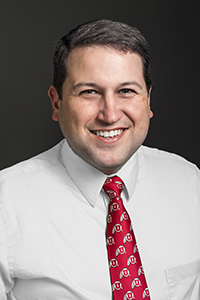LEARNING SPACES-STUDENT COMPUTING FEES
$3.7M earmarked for student technologies and services

A female student wearing a green hoodie scrolls on the trackpad of a MacBook Air in Lassonde Studios. Image courtesy of the University of Utah.

The University of Utah has earmarked approximately $3.7 million next fiscal year for student-related technologies and services.
Learning Spaces-Student Computing Fee (LS-SCF) proposals are vetted in March, and awards are transferred to applicants in July. The funds will be used in fiscal year 2025, which runs from July 1, 2024, to June 30, 2025.
“I’ve always been extremely proud to be part of this process,” said Digital Learning Technologies (DLT) Director Jon Thomas “It’s time-intensive and complicated, but vital to student success.”
The fee, which Thomas said dates to the 1980s, is a mandatory charge included in tuition that supports technology needs for students across campus. The fee is currently $26.35 for the first credit hour on a sliding scale that maxes out at $119.45, or 20.2% of the total fee, for 15 or more credit hours per semester.
Where the money goes
The money generated must support students, be needs-based (support the greatest number of students possible), and account for existing common resources or campus software agreements, like Adobe Creative Cloud and Microsoft 365.
A portion of fees is allocated toward central services like UMail and wireless network access, information security, online course management, and administrative applications for students. Most funds are distributed to colleges, libraries, centers, and interdisciplinary programs on campus that have submitted funding request proposals.
Here are some examples of LS-SCF-supported learning systems:
- Canvas
- Kaltura
- AV Classroom Foundation Rooms
- Zoom
- Portfolium
- Gradescope
- Blackboard Ally
Who makes the funding decisions
Interested organizations submit proposals, typically in mid-January. Proposals, which must include a brief video summary and supporting documentation like reconciliation documents from previous awards, are reviewed by a task force of IT professionals who conduct individual interviews with each applicant group. Proposals are then reviewed by the Teaching and Learning Portfolio (TLP), which judges projects on their merits and direct impact on the teaching and learning experiences of students, before submitting them to the Budget Office.
This year, 26 proposals with hundreds of projects and line items (products and services) were awarded.
How and when to apply
The deadline has passed for FY2025, but the FY2026 cycle begins again next October. Please review DLT’s Learning Spaces proposal submission guide for information on how to apply.
Note: Applicants seeking LS-SCF funding to replace lab computers must provide at least
four months of data that details lab usage. Although not required, the LabStats tracking tool
provided by the university is available to assist in lab data collection.
If you have additional questions as you work on your proposal, please email classhelp@utah.edu.
A brief timeline of the Teaching & Learning Portfolio, courtesy of Jon Thomas
The TLP:
- Helped negotiate the university’s campus license with Adobe
- Established a five-year refurbishment schedule for audiovisual equipment
The TLP started to bring disparate funding sources together, including LS-SCF, the Student Computing Advisory Committee (SCAC), and eclassroom.
- For LS-SCF proposals, the TLP:
- Asked requestors to submit a single LS-SCF proposal
- Required maintenance requests to be itemized
- Appointed a task force to assist with the technical review of projects
- The TLP established strategic priorities:
- Support core teaching technology platforms
- Maintain and refurbish general use learning spaces
- Develop strategic IT governance initiatives that may need seed funding
- Encourage quality in discipline-specific learning experiences
The TLP authorized the repurposing of equipment from Milton Bennion Hall and Orson Spencer Hall, which were slated for demolition.
The TLP improved communications around Learning Spaces awards.
The Student Computer Lab Usage initiative collected usage profiles on student computer labs across campus to determine their purpose, type of computing environment, and type of devices. Lab statistics helped the TLP better monitor how lab computers were used, leading to data-supported funding decisions.
In response to the pandemic, the TLP authorized installing hybrid classrooms in all general use teaching spaces and made home studio kits broadly available to faculty.
The TLP simplified LS-SCF deliberations by:
- Asking the task force to categorize projects as fund, do not fund, or on the bubble
- Requiring the participation of the full committee on final decisions
Node 4
Our monthly newsletter includes news from UIT and other campus/ University of Utah Health IT organizations, features about UIT employees, IT governance news, and various announcements and updates.
